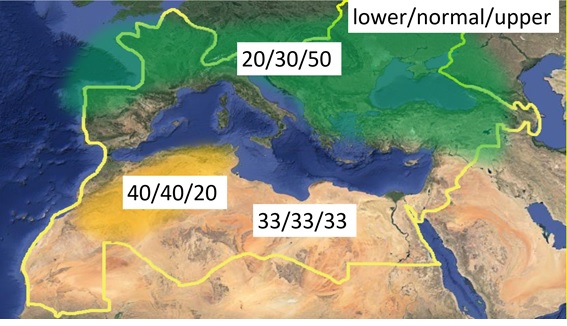Email: dgacmad@acmad.ne/dgacmad@acmad.org site web: www.acmad.net
This region typically covers the Mediterranean area in Africa between the Mediteranean Sea and Sub Saharan Africa. The regional climate is hot in summer and wet winter. The regional climate is mainly dominated by winter and summer regimes. Large scale circulation in the mid latitude exerts a strong influence on winter precipitation trough the North atlantic Oscillation(NAO). ENSO, shifts in the upper troposphere jet over Eastern mediteranean region, synoptic systems passing over central and northern Europe and Scandinavian pattern are additional features impacting Mediterranean winter climate. In summer, Asian and African monsoons , blockings, mediteranean SSTs significantly modulate mediteranean climate.
Major sources of seasonal climate variability and predictability in the region include Sea Surface Temperatures (SSTs) of the equatorial Pacific (ENSO region), the Tropical North Atlantic SSTs, Eurasian snow cover, Scandinavian pattern, the North Atlantic Oscillation, the Quasi Biennal Oscillation, Tropical intrusion, troughs, ridges and blockings.
It is recognized that soil moisture is another important source of local climate variability and predictability over the region. Uncertainties on SST forecasts over the tropical north Atlantic, the NAO and soil moisture forecasts over the region are documented.
Improvement of ocean models over the tropical north Atlantic, representation of stratosphere-troposphere interactions in climate models, land surface models over the Mediterranean region, and coupled ocean-atmosphere-land models are required to provide better inputs to operational seasonal prediction for the region. .
Floods and droughts, summer heat and cold waves, abnormal onsets are the main climate hazards of the region. Shortages of water, reduction in food production due to droughts occur. Roads and other infrastructure damages, loss of lives and properties are associated with floods have become a matter of strong concern in cities of the area.
The RCOF
It has been held once or twice a year usually in late November for December-January-February season and between February and March for March-April-May season. It involves 5 countries in North Africa namely Morocco, Algeria, Tunisia, Lybia and Egypt. National Meteorological and Hydrological services of the region, WMO Global Producing Centres for Long Range Forecasts, are the major collaborating partners. AGRHYMET Regional Centre are the major collaborating partners.
 |
Figure : Seasonal precipitation forecast for north Africa |
The approach involves assessment of outputs from global single and multimodel ensemble forecasting systems, statistical seasonal forecasting tools, analogue years, persistence, composites and trends analysis as well as available findings from climate studies at local, national, regional and global levels. Interpretation of models outputs uses available verification products. The assessment made is discussed during a briefing and a consensus outlook generated for users. Precipitation and temperature outlooks are provided.
The African centre for Meteorological Applications for Development (ACMAD) is the main coordinating institution. It is collaborating with Meteorological Services of Morocco which is the Long Range Forecasting node of the proposed North Africa-RCC network.
Contact details: African Center of Meteorological Applications for Development , ACMAD, 55, Avenue des Ministères, PL6, BP 13184, 1er Arrondissement, Niamey Plateau, Niger, Tél: (+227) 20734992; Fax: (+227) 20723627.
Email: climat@acmad.org, website: www.acmad.org
User involvement
Users from agriculture, water, health, disaster management and media communities are invited to the forum for exchanges, interactive discussions on the historical, current and expected climate conditions, related impacts, advices and recommendations to cope with negative impacts or increase benefits linked to possible opportunities due to favorable climate conditions.
Way forward
Scientific research on ocean-land-atmosphere modeling, new predictors for statistical forecasting tools, local and regional climate variability and trends studies, assessment of regional performance of forecasting systems including their strengths and weaknesses in predicting NAO, tropical Atlantic SSTs, QBO and other features modulating significantly regional climate variability are proposed to improve consensus outlook products. Specifically better understanding and prediction of the Tropical North Atlantic SSTs, NAO and interactions between troposphere and stratosphere are required. .
Participation of climate service providers of the region in tourism sector forums, contingency planning meetings, agriculture season planning workshops, vulnerability assessment and water forums is to be supported for effective and wide exchanges, interactions and consensus building on sector relevant impacts, adaptation measures, advices and recommendations. Provision of climate outlook for summer season with emphasis on temperature is needed for further engagement of a wider range of users and expansion of forecasts application opportunities. Provision of discharge outlooks and vigilance for regional hazards is required.
Clik here to see MEDCOF outlook bulletinClik here to see MEDCOF Verification
Clik here to see MEDCOF Monitoring